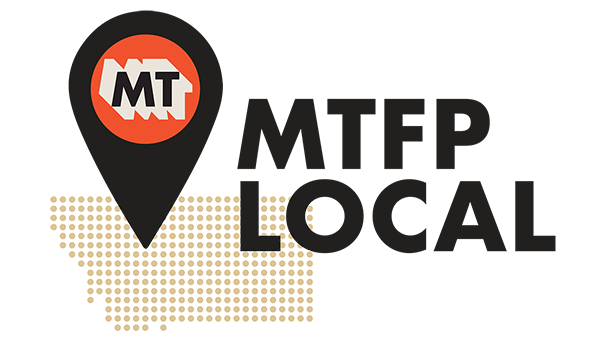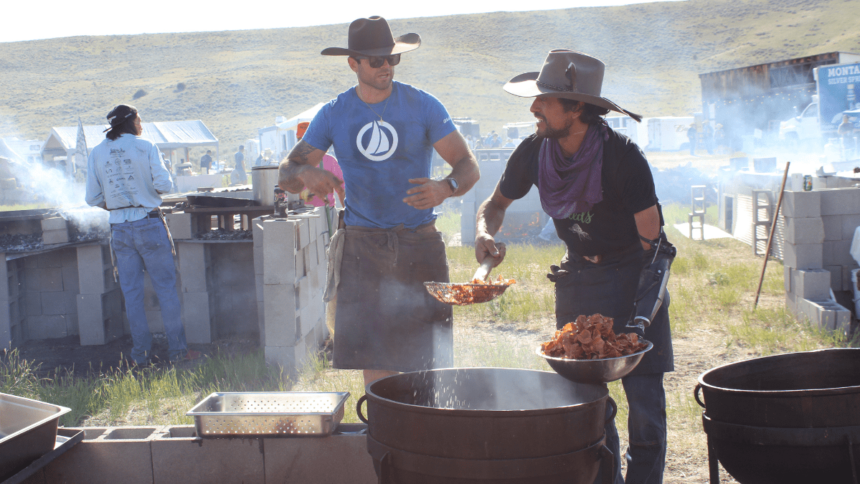HELMVILLE — Sitting on hay bales in the bed of an old pick-up truck, Montana rancher Cooper Hibbard looked out to a crowded pasture. Standing in between sagebrush, people ate lamb raised on Hibbard’s ranch and smoked over a fire that morning.
Hibbard was emotional as he talked about the lamb, slaughtered just six days before. They were so loved, Hibbard said. The lamb spent their lives eating diverse species of grasses, and the land’s nutrients now circled through in the meat.
“The connection between the land, people and animals is sacred,” Hibbard said. “Land is kin. It deserves to breathe.”
It’s a rarity these days for ranchers to see people eating the animals they raise. In the conventional U.S. agricultural market, ranchers sell livestock to out-of-state feedlots and can’t track where the meat is ultimately sold. Just 5% of cattle raised in Montana are processed here.
But some Montanans are trying to change that.
On the summer solstice, Hibbard spoke to the crowd at the Old Salt Festival. It was the second year of the event celebrating Montana food, landscapes and music — put on by the Old Salt Co-op, a collection of four local ranches selling meat directly to consumers, including Hibbard’s Sieben Livestock near Helena.
Credit: Isabel Hicks / MTFP
The festival is held in northwest Montana on the Mannix family ranch. Last year, it hosted 1,600 people, and this year grew to 2,000. The three-day event featured conservation-focused panels, Western artisan vendors and meats that an ensemble of chefs roasted over a wood-fired stove.
“It does have great music, but it’s a food festival first. It’s really meant to highlight the culture that it takes to maintain regenerative agriculture,” Cole Mannix, a fifth-generation rancher and co-founder of Old Salt Co-op, told Montana Free Press.
“I think agriculture is reduced by a lot of people to just the production part. But the whole system has to work if you’re going to produce something that’s nourishing. This is a celebration of the whole connection between the producer, the consumer, the land and everything in between,” Mannix said.
The event is held on grassland the ranch uses for cattle grazing. But for the weekend, crews truck in large tents for vendors and speakers, port-a-potties, water coolers, electric fencing to deter grizzlies and the stage.
The festival — which Mannix said has yet to make a profit — is centered around building consumer support for an alternative agricultural system.

Credit: Isabel Hicks / MTFP
The co-op’s business model essentially skips the middleman, Mannix said. Economists estimate that today, only four companies — Tyson, JBS, Marfrig and Seaboard — control about 85% of the U.S. meatpacking industry. Their market power means most ranchers must sell their livestock at whatever price the companies set. According to federal statistics, about 39 cents of a dollar spent on beef at a grocery store goes back to the rancher.
But Old Salt ranches retain ownership of their product through the supply chain. The meat is finished on pasture — not a feedlot — processed locally, and then sold directly to consumers online or at restaurants owned by the ranchers in Helena.
The idea really took off during COVID when people saw first-hand the fragility of the consolidated global food system, Mannix said.
“We really are trying to broaden that definition of agriculture to mean all of us,” Mannix said. “The consumer is just as much a part of this as we are.”
But changing the system is far from easy. For one, livestock finished on grass, rather than grain, take longer to grow and get the fat and marbling consumers expect, Mannix said. That means ranchers are caring for livestock for an additional year on average. Regenerative — or high-density, multi-pasture grazing — can also require more labor because cattle are moved more frequently.

Credit: Isabel Hicks / MTFP
The ranchers also must market their own products, build a customer base, manage a website and ship orders nationwide.
Another hurdle is the lack of local processing facilities for ranchers looking to keep their dollars in-state. The 50-so facilities statewide are often hours away for ranchers and book up months in advance.
The co-op currently processes animals in a small facility in Helena. But the space can’t accommodate slaughter, and it is quickly outgrowing its capacity.
In March, the co-op purchased land to build a slaughter and processing facility outside Helena. It hopes to open in 2025 and process about 4,000 USDA-inspected animals a year.
Building the facility will cost millions, and the co-op is still trying to raise capital, Mannix said. But securing the land is a huge step forward.
Dan Miller, the CEO of Steward, a company that provides loans for alternative agriculture projects, is a key partner of the Old Salt Co-op and has loaned them more than $6 million.
Miller founded Steward in 2016 to provide loans for alternative agriculture projects that struggle to garner funding. Much like how the meatpacking companies have consolidated, so have the smaller banks and loan providers, Miller said.
Typically, existing producers can get loans to buy more land or equipment, and government loan programs focus on commodity crops like corn, soy and wheat. There aren’t many options for people just getting started or experimenting because banks want guaranteed high returns, Miller said.
Many of Steward’s investments are focused on value-added processing, like Old Salt. Each loan — on average $100,000 — is from individual investors who care about the viability of regenerative agriculture, Miller said. Projects still need to generate a “reasonable” return for investors but can focus on the entire food system.
“The only way it’s going to work is if the producer has control of their product through the end,” Miller said.

Credit: Isabel Hicks / MTFP
Saturday morning of the festival, the Mannixes led people on a walk through a pasture to a hill on the ranch called Eagle’s Point.
The ground brimmed with sweet clover, wild irises, sagebrush and lupine. The ranchers described the work of managing the landscape, pointing out logging scars and burn piles and where they brought in sheep to eat weeds like larkspur.
At the top of the climb, Texas singer-songwriter Brendon Scott Green had brought his guitar and amp to play away from the larger festival. He played among bird calls as the stream downhill wove through the grasslands.
This, Mannix said, is the kind of connection to the landscape he hoped the festival would inspire. To him, it’s about transparency — people can see the land where their food was raised and decide for themselves if it’s trustworthy.
“We really try not to be a brand that is focused on the cowboy hats, the ropes, boots and spurs. It’s not about the “Yellowstone” kind of image of the West,” Mannix said. “So many meat brands try to make the rancher a hero or something. But I think that’s a huge mistake. Because even the best rancher will fail when selling into an extractive system.”

In-depth, independent reporting on the stories impacting your community from reporters who know your town.
LATEST STORIES
Dealing with drought and poisoned creeks in Fort Belknap
NASA research shows the loss of nearly 60% of surface water on the Fort Belknap Reservation between 2017 and 2022. What does that mean for residents on the ground?
A beginner’s 12-month tortilla journey
Exactly 12 months ago, I started a culinary journey to learn how to make corn tortillas from scratch. As with other kitchen adventures I’ve undertaken over the years, this obsessive approach was meant to transform me from absolute newbie to intermediate proficiency as quickly as possible. And I’m here to report back on this amazingly fun and delectable undertaking.
Missoula passes rules restricting camping on city property
Nearly a year after declaring a state of emergency regarding homelessness and months of grappling with next steps, the Missoula City Council approved controversial rules restricting camping on city property.





